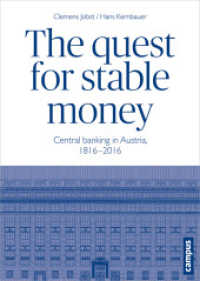Full Description
This open access book presents a unique interdiscplinary analysis of urban projects promoted by the EU from a comparative perspective This book presents cross-sectional and cross-time analyses at the territorial level targeted by these initiatives focusing on the design, theory and impacts of urban projects developed under the framework of initiatives promoted by the European Union. The book includes a new methodology to analyse the design and theory of urban plans (the comparative urban portfolio analysis) and quasi-experimental strategies to perform impact assessment at the neighbourhood level (the territorial target of those initiatives). Although empirical analyses focus on examples in Spain, the resulting analytical and methodological outcomes of these studies can be applied in a broader context to analyse integral urban policies in other countries.
Contents
Chapter 1. Introduction: EU urban initiatives as integrated multi-level policy mixes. Policy levels, policy dimensions and added values of integrated local strategies from a comparative perspective. By Clemente J. Navarro.- Part I: Better urban policies or added value I: the practice and learnings on the policy integration strategy at the local level.- Chapter 2. The nature and the policy added values of EU urban integrated development initiatives: research issues and strategies. By María Jesús Rodríguez-García, Clemente J. Navarro and María José Guerrero-Mayo.- Chapter 3. Evaluating the design of integrated urban development initiatives: evaluability, plan quality and planning learning processes. By María José Guerrero-Mayo and María Jesús Rodríguez-García.- Chapter 4. The agenda of urban sustainable development initiatives: challenges, goals and actions across policy areas. By María Rosa Herrera-Gutiérrez, Lucía Muñoz García and Enrique Pastor Seller.- Chapter 5. The integrated strategy as urban policy innovation proposed by the EU: do cities apply it?. By Enrique Pastor-Seller, María José Dorado-Rubín, María José Guerrero-Mayo and Clemente J. Navarro.- Chapter 6. Opening the black box of integrated urban development strategies: on causal mechanisms and policy theories. By Clemente J. Navarro and María Jesús Rodríguez-García.- Part II: Better spaces to live or the added value II: the impacts of the policy integrated strategy on neighbourhoods and residents.- Chapter 7. The impact of EU integrated urban development initiatives: research strategies beyond 'good practices'. By Alicia Domínguez-González and Clemente J. Navarro.- Chapter 8. The impact of the URBAN Initiative: on residential mobility and 'contextual exposure' to EU integrated urban development strategies. By Clemente J. Navarro, Manuel Fernández-García and Alicia Domínguez-González.- Chapter 9. The impact of the URBANA Initiative: socioeconomic conditions, self-perceived health and quality of the built environment. A time-trend analysis of repeated cross-sectional data. By Ángel Ramón Zapata-Moya and Clemente J. Navarro Yáñez.-Chapter 10. 'Cultural buzz' on the neighbourhood: the impact of the URBAN I Initiative on cultural consumption opportunities. By Cristina Mateos Mora and Clemente J. Navarro Yáñez.-Chapter 11. The 'historical city centre' question. How have the historical centres of major cities changed after the intervention of the URBAN I Initiative?. By Manuel Fernández-García, Francesca Donati and Clemente J. Navarro.- Chapter 12. Conclusions: Policy evidence about the added values of EU integrated urban initiatives as local policy mixes and multi-scalar comparative research. By Clemente J. Navarro, María Jesús Rodríguez-García and María José Guerrero-Mayo.








